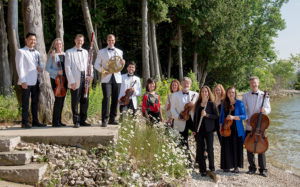 Midsummer’s Music grew out of discussions between Jim Berkenstock and Door County residents Bob Hastings and Hugh Mulliken. Bob was a real estate developer and one of the original owners of the Church Hill Inn. He was interested in music and in improving the cultural offerings in Door County during the “shoulder” seasons.
Midsummer’s Music grew out of discussions between Jim Berkenstock and Door County residents Bob Hastings and Hugh Mulliken. Bob was a real estate developer and one of the original owners of the Church Hill Inn. He was interested in music and in improving the cultural offerings in Door County during the “shoulder” seasons.
Jim and Jean’s neighbors, Bob and Charlotte Yeomans, took the initiative of hosting a get-together in their Door County home to discuss the feasibility of a June chamber music offering. They invited Carl and Adele Hake, Gretchen and John Maring, PMF president, Virginia Terhune, and others, including the Mullikens and the Hastings. The discussion explored both pros and cons. Concerns included the slowness of the season, the possibility of conflict with the PMF, and the viability of chamber music as a draw.
A subsequent meeting included those most favorably inclined from the previous meeting plus Suzanne Gombrich, Peter and Dianne Trenchard, and Penny and Doug Schultz. The name Midsummer’s Music Festival was floated as a connection to the summer solstice (a time joyfully celebrated in areas of Scandinavian heritage). Planning for a first season in 1991 followed, with five concerts scheduled around Ephraim’s Fyr Bal Festival. Midsummer’s Music started with concerts in the home of the Trenchards in Sister Bay and the Hakes in Sturgeon Bay, and followed with two performances at the Hardy Gallery and a children’s concert at the Ephraim Village Hall. The first year’s festival was over in less than a week. Most people in the county had no idea it had happened, but there was sufficient turnout to encourage planning for a second year.
A total of eight musicians performed that first season. Added performances at the Miller Art Center and The Clearing the next season increased the festival slightly, where it remained for the next several years except for an added children’s concert at the Miller, outreach concerts at Scandia, and a special benefit in 1996 for the YMCA building fund. Broadcasts on Wisconsin Public Radio began in 1993, and the first commercial recording followed in 1994. The second recording was released in 1998.
Midsummer’s Music was run by a committee under the auspices of the Peninsula Arts Association (PAA), which also offered logistical and financial support. By February 1995, a board of directors formed, and Wisconsin recognized Midsummer’s Music as a not-for-profit organization. In 1996 Midsummer’s Music received its 501(c)(3) tax-exempt status and became independent of the PAA.
By 1999, the number of performances was up to 11 and covered a little more than two full weeks. David Perry (member of the renowned Pro Arte Quartet) joined the group as first violinist in 2000. Another Pro Arte member, Sally Chisholm, violist, joined the ensemble in 2004. The Midsummer’s ensembles make up a “family” of musicians whose talents individually and collectively are of the highest caliber.
In 2003, a key supporter stepped forward with the determination and foresight to help Midsummer’s Music establish an endowment. Substantial long-range planning ensued, leading to the establishment of a Midsummer’s Music Endowment Trust, administered by the Door County Community Foundation. We now have approximately $850,000 invested or pledged toward our $1,000,000 goal which will ensure the future vitality of Midsummer’s Music.
In 2002 the first Labor Day Weekend concerts began. The Seven Last Words of Christ by Joseph Haydn was presented from 2004 to 2010 during Easter week, involving clergy and lay speakers from various Door denominations, and performances by local actors and poets.
In 2005, Midsummer’s Music Festival received the Peninsula Arts Association Fred J. Alley Visionary Award, recognizing the importance of Midsummer’s Music to the Door County cultural community.
From 2005 to 2010, Midsummer’s Music presented The Chicago Early Music Consort with their annual presentation of A Renaissance Christmas in mid-December. In December 2011, Midsummer’s Music sponsored the Wisconsin Brass Quintet who presented Holiday Brass.
Midsummer’s celebrated 25 years in 2015 with an event dubbed “Big Top Door County.” Nearly 150 people gathered under a large, white tent on the grounds of Berkenfeld in Baileys Harbor to commemorate the milestone and to enjoy a once-in-a-lifetime concert featuring the ensemble and several well known Door County performers and singers.
In 2017, with support from the MMG Foundation, Midsummer’s Music created its Composer-in-Residence program and named 18-year-old Jacob Beranek to that position. After Jacob’s four-year tenure, Will Healy succeeded him and continues to serve in that position.
Also in 2017, the Board of Midsummer’s Music retired the word Festival from use, reflecting the organization’s significant growth and broadening of its mission to include additional concerts throughout the year, intended to expand Midsummer’s constituency to all of northeastern Wisconsin, including the city of Green Bay.
Reflecting that expanded mission, in 2018, Midsummer’s Music launched the Griffon String Quartet as the centerpiece of a program to embed a resident string quartet – a professional chamber music ensemble – into the classrooms of schools throughout Door and Brown counties. This groundbreaking project was designed to enhance student learning and academic achievement through increased exposure to – and participation in – music.
Midsummer’s Music is run by a dedicated board of directors, staff, and volunteers. James Berkenstock continues to serve as Artistic Director. We invite your comments, suggestions, and inquiries at (920) 854-7088 or at office@midsummersmusic.com.
